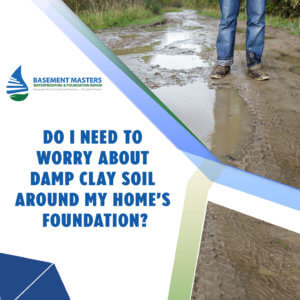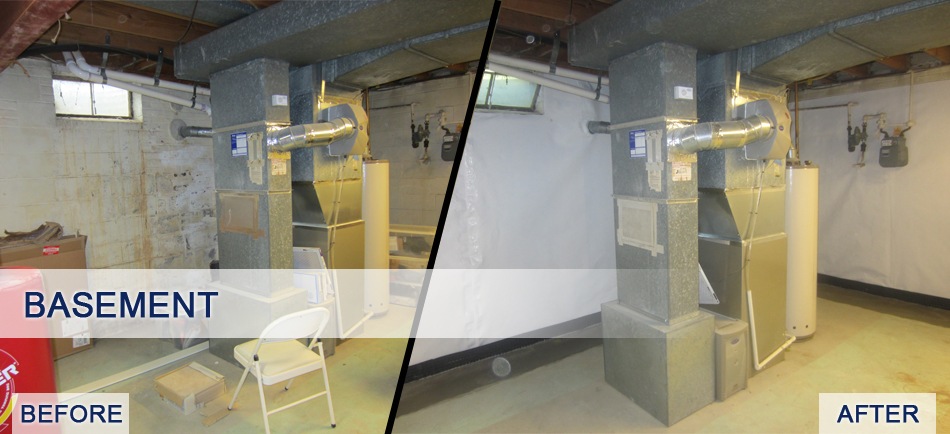- LIVE Response 8am-8pm | Saturdays 9am-5pm
- Get Financing - APPLY NOW!
- HQ: (571) 350-8292
- Maryland: (301) 841-6761
- NOrthern Virginia: (703) 721-7148
 Expansive soils, such as clay, can cause a lot of damage to many houses. For any homeowner, wet clay soil is terrible news. If you don’t act now, you could be facing major structural issues that compromise the structural integrity of your home. Here’s all you need to know about these soils and how to keep your house and foundation safe.
Expansive soils, such as clay, can cause a lot of damage to many houses. For any homeowner, wet clay soil is terrible news. If you don’t act now, you could be facing major structural issues that compromise the structural integrity of your home. Here’s all you need to know about these soils and how to keep your house and foundation safe.
As the name implies, damp clay refers to wet soil or soil with a lot of moisture. In the presence of rainfall, the soil will swell and expand. Excessive rainfall, snowmelt, or ruptured pipes near the foundation are common sources that contribute water into the soil.
Clay soils can absorb water with incredible efficiency and swell several times their original size, despite their otherwise microscopic particles.
When clay soils come in contact with water, they swell or expand. They can cause foundation settlement, heaving, shifting, and cracking, all of which are expensive to repair! Naturally, the soils containing the most silt or clay have the greatest potential for causing foundation problems by way of swelling.
Clay can get wet due to heavy rains or poor drainage. Not only will rain saturate the soil, but water will pool around the foundation if your existing drainage systems are insufficient, essentially causing the same problem.
Excess moisture in your soil could also be caused by leaking water lines, sewer lines, underground streams, and high water tables. We recommend checking the foundation once a year, both inside and out, to assess its condition.
· Strong rains: Clay absorbs and holds water from heavy rains, making it soft and pliable. Consequently, the soil becomes weaker, which makes it possible for the foundation to shift.
· Poor drainage: When water accumulates around your foundation after a rainstorm or snowfall, the soil absorbs it and expands. This can result in foundation fissures and bowing walls.
Make sure to check the structural integrity of your home at least once a year, beginning from the inside out. Examine any concerns that could be caused by expanding soils. Monitor any potential changes in the integrity of your foundation for any worsening signs and how quickly any problems might be growing.
Summer and spring bring especially difficult conditions for your house to bear since the soil conditions vary dramatically at these times. During either season, your foundation is more likely to experience settlement and cracking. Other telltale symptoms of foundation issues that should communicate the need for you to act include:
· Your doors have gaps and spaces surrounding them.
· Brick veneers with cracks
· Floors that are sagging or bouncing
· Self-closing or self-opening doors are available
· Stick-to-the-frame doors and windows
· The soil shrinks during hot weather
Clay soils found in the active zone, an area more heavily influenced by water or climate changes, are highly prone to expanding and contracting depending on soil moisture levels. The earth expands and exerts strain on your foundation walls (a force referred to as hydrostatic pressure) during the wet season, which can cause them to crack or bow inward, reducing their stability.
Drought conditions can be equally severe. When the clay dries, it shrinks and forms gaps that can’t support the weight of your house. Floors may be uneven, walls may develop cracks, and windows and doors may become stuck. Where gaps occur, the foundation can become displaced by settling into the negative spaces over a short period of time.
Due to the vast surface area of their particles and the structure of the minerals present in the soil, clay and water have a stronger interaction with each other than other soils. These minerals frequently have an impact on soil movement and behavior.
The soil loses its ability to support the weight of your home when it swells. Swelling foundation soil can also exert upward stress on the foundation, causing it to move as far as up to eight inches! As a result, your floors may become uneven.
The majority of foundation repair efforts should be focused on controlling it. Wet clay soil beneath the foundation cannot be removed. The most rational thing to do is to reinforce the existing integrity of your foundation as well as reduce the amount of damage being dealt to your home.
· To avoid water ponding, use positive site drainage around your home.
· To limit the amount of water that saturates the soil, use drip irrigation to water your plants and trees.
· Trees and vegetation should be kept at least 10 feet away from your house. This is because they both absorb water and dry out the soil.
· Install and maintain proper gutter and downspout systems to keep water flowing away from your home.
· Make sure the landscaping and soil around your home, particularly in the yard, have positive grading that slopes away from your house so that water may flow freely.
· To avoid a clay bowl look, compact the backfill around the base.
· To avoid overwatering your lawn, use sprinklers with timers.
When constructing a new home, ensure that the foundation wall is strong enough to withstand numerous destructive causes.
Contact your foundation repair professionals here at Basement Masters for a free foundation examination and price consultation if you feel that moist clay soil is weakening your foundation. Give us a call at (571) 371-0936 to schedule today! Our experts will come to your house, inspect your foundation for damage symptoms, and then propose a solution that fits your family best.

Take A Look For Yourself!
Visit our Before and After gallery for shots of completed projects.We are glad to help increase the quality of life in your home!